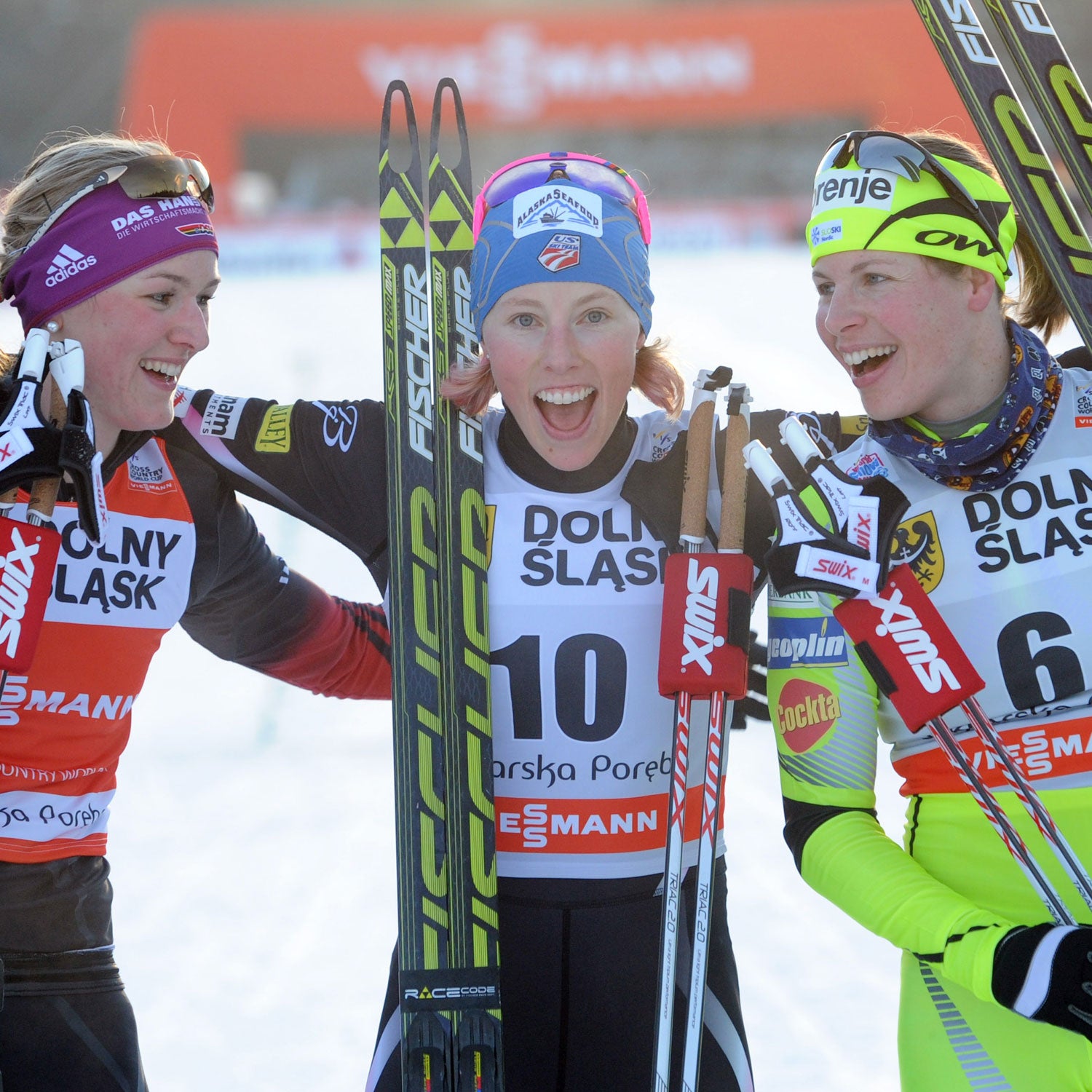, 33, is an Anchorage-based professional cross-country skier, a three-time World Cup sprint champion, and a four-time Olympian. Her latest pursuit? Gearing up for the 2018 Olympics in Korea, spending time with her four-month-old son, and working with the International Ski Federation (FIS) to make sure new moms like herself are accommodated on the World Cup circuit.
Stats
Age: 33
Hometown: Anchorage, Alaska, by way of Salt Lake City
Day job: Full-time skier
Sleep: “I usually wake up around 7 a.m. and try to be in bed by 10:30 p.m. I need at least eight hours of sleep.”
Go-to meal: “One of my favorite breakfasts is a big omelet with veggies, Canadian bacon, and toast and fruit on the side.”
Training schedule: “Training six days a week, two times per day. Sunday is my active rest day—usually just a light hike or bike up to one hour. My main training activities are roller skiing, running, cycling, SkiErg, and strength training. It’s a fun mix.”
- Monday: Two cardio aerobic training sessions (two to three hours per session)
- Tuesday: Morning intervals and afternoon strength in the weight room
- Wednesday: Two easy aerobic sessions (1.5 to two hours per session)
- Thursday: Aerobic training with speed (two to three hours per session)
- Friday: Intervals and strength again
- Saturday: A long-distance workout (three to four hours), with the afternoon either off or short aerobic
Racing schedule: “I’m on the road going from venue to venue in Europe from mid-November through March.”
Free time: “When I’m home in Anchorage, I love to walk to the coffee shop with my mom and catch up. Now that we have a baby, we spend lots of time just playing with him. I love just having one day a week where I don’t have to be changing in and out of workout clothes all day.”
Favorite piece of gear: “M�� heart rate monitor. I love getting stats on my workouts like distance covered, max speed, calories burned, etc.”
Favorite place to race: “Racing in Oslo, Norway, where skiing is said to have started, is the closest thing we have to the Super Bowl. Fifty thousand fans come out to watch us race, and the energy is amazing.”
Personal best (sport): “A big highlight in my career was winning the team sprint at the 2013 World Championships with my teammate Jessie Diggins. It was the first gold medal ever for the USA at a World Championships in cross-country, and it was so fun to be on the top of the podium with a teammate.”
Personal best (life): “M�� biggest life highlight came this spring when my son was born. We didn’t know whether we were having a boy or girl, and when he came out, my life changed forever. I’ve been loving every single moment of getting to know our new little guy.”
OUTSIDE: Have you always been skiing professionally?
RANDALL: I have pretty much always been a skier. My first Olympics was at 19, and I have dedicated myself to full-time training since then.
It was special to be competing so young in cross-country skiing because it’s a sport where most athletes peak in their early 20s or 30s. I was inspired to try to win a medal, which is something that had not been done in (USA) women’s cross-country skiing. After the games, I made a ten-year plan to build myself into an Olympic medal contender.
Do you remember the moment when you decided you were going to try to make a career out of skiing?
It wasn’t conventional wisdom that this was a worthy pursuit, because the U.S. hadn’t had any success in the sport. It was a total unknown in terms of whether it would be possible to make a living, but I had this feeling that I would be successful and make it work.
I remember my grandfather pulling me aside and going, “Okay, you’ve made the Olympic team. Now maybe it’s time to go to college,” and I was like, “No, I really think I can do this, but it’s going to take me some time.”
Does your job ever feel like a job to you?
There are days when it’s pouring rain and you’d prefer to stay on the couch, but you go outside and you train anyway. Most days, though, it feels like I get to do what I love. It is definitely all-consuming like a job—I am on call 24/7. Every decision I make, in terms of what I eat and when I go to bed, all affect training and performance. I train twice a day, and when I’m not training, I’m recovering, so it’s full-time.
What’s a typical day look like for you?
I usually have a big breakfast, and then head out for my first training session. I train for a couple of hours, then have a snack and do some body work. Then I have lunch and take a nap for a couple of hours, wake up, eat again, go out for the second training session for another couple of hours, come back and stretch, and have dinner. That’s pretty much what I do six days a week for almost 11 months of the year.
I’m pretty lucky that I can train right out my front door most days. I might be on my roller skis cruising around, and I’m also a ten-minute jog from a trail network that connects right into the mountains, where I can be out running for pretty much as long as I can stand it.
Do you listen to music while you’re training or go with silence?
Yesterday I was out for 2.5 hours, so I had my playlist on while I was doing the fast track. The sun was out, and it was a fun training session. It varies, but I listen to Katy Perry, Rihanna, Lady Gaga…I love country, too.
You recently had a baby (congrats!). Were you worried about how having a baby would affect your career? How has it been going balancing that and training?
His name is Breck—after the that happens in Breckenridge every year—and he is just shy of four months old. It’s so fun that I get to go out and train, then come back home and spend time with him. Having a baby is definitely an unknown, and I’ve had an amazing career, so it was hard to think about taking a year away from racing, but I’d heard a lot of good things about women coming back stronger after babies, and I knew it was something that I wanted to do.
My husband works for the FIS in winter, but he’s able to be home with Breck during the day while I’m training in the summer. We’ll all travel together during the season.
You’ve been an advocate for new moms in the sport. Can you tell me about your efforts with the federation to make the World Cup more accommodating for new moms?
When I was thinking about starting a family and trying to figure out what that meant for my career, I looked around for information, and there were really no clear policies about what happens if you’re competing and want to take a year off. I’ve been the athlete rep to the FIS for seven years, so I had a good relationship with the staff and committee. I approached them about making this experience positive and workable for athletes, and they were receptive.
I don’t want athletes to feel like they have to leave the sport if they want to start a family. I want athletes to understand what happens if they take a year off, that they’ll be supported when they come back. We decided that moms need an on-site caretaker, so it became about what we can do to make sure the caretaker has access to certain areas and accommodations. And then how you can be a mom right there at the race—you know, you might need an area to go feed your child or change diapers or things that are not normally at a venue.
Did you meet any resistance, or were people accommodating?
There were concerns from the organizers that this might increase competition costs, and they are already pretty strapped. They [the sport’s governing body] didn’t feel comfortable adding these extra things to the rules, so they decided to make the recommendation to the organizers about having a family room, etc. They were kind of like, ‘Let us see how it goes for a year or two, and then we will talk about adding it into the official rules.’ It’s a really easy thing, so I’m kind of surprised they were not willing to write those rules in, but I hope after a year or two we can make it official.
Do you have any other goals in this respect?
I’m really fortunate that I have a team and sponsors who were supportive of the idea of me starting a family. But there is no industry standard for what happens with your contracts and what’s required when you decide to take the year away from racing. You could lose your whole income because there is no maternity leave, so it might be interesting to explore guaranteeing a certain percentage of existing contracts to racing moms or some sort of support. A male athlete can have a child and keep racing, and they don’t have to slow down. I think it’s in the interest of our sport to keep our top athletes competing, and we can do that by offering support.


